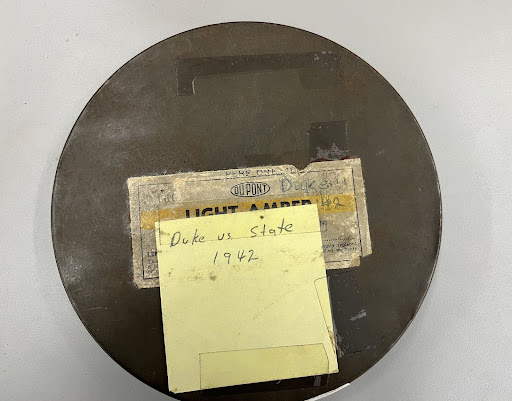
Film reel can from UA 015.401, North Carolina State University, Athletics, Football Audiovisual Materials, carton 112

Film reel can from UA 015.401, North Carolina State University, Athletics, Football Audiovisual Materials, carton 112
This blog post contributed by Katelyn Cuomo.
This semester I worked on a film survey project in NC State’s Special Collections Research Center. It was a unique opportunity for me to work with a different type of medium than I am used to. It is pretty amazing that we are able to access films that were made decades ago. When I saw a film reel from one of the NC State football games in the 1930’s it was a surreal experience.
Technology is so different now you can even shoot a movie on your phone. It is so cool that we have these films that can transport us to another time. It is a window into the past to see what the world looked like. From a historical perspective, film is an unbelievable format to reference because it feels so immersive. This is why it is so important that we preserve film reels, because they provide such a unique and immersive experience.
This film survey was conducted in order to gain a better understanding of the size of our film collections. The University Archives and manuscript collections contain thousands of 16mm film and some 8mm film reels. With the knowledge that the film reels will eventually deteriorate, it was necessary to conduct a survey to evaluate the levels of damage caused by vinegar syndrome and other condition issues. The next step will be systemically reformatting selected film reels for preservation. We will prioritize reels for reformatting and make reappraisal decisions according to the results of this film survey.
This project involved filling out google forms that gathered information like the title of the film, the date it was created, the type of container it was stored in, whether it was black and white or color, whether it was silent or had sound, etc. In this project, I had hands-on experience with 16mm acetate films in our collections. Over the course of this project, I surveyed 256 films out of thousands of films in our collections.
Working with film is very different from working with papers and documents. I had to wear gloves and a mask because some of the films have a strong odor due to vinegar syndrome, a form of chemical deterioration that causes film to shrink and eventually disintegrate. Vinegar syndrome poses a threat to the long-term preservation of film. It is inevitable that this type of damage will occur to acetate film over time but it can be slowed down by storing film in a cool, dry environment. When severe enough, vinegar syndrome renders film unplayable and entirely inaccessible due to warpage, shrinkage, and brittleness. I tested all of the films for vinegar syndrome using A-D strips. These acid-based pieces of paper change color in the presence of acidic vapor, indicating how severe the degradation is. It is useful to use the A-D strip readings to inform preservation decisions. The image below shows what the A-D strips look like before they have been exposed to the film and the chart that I used to determine the A-D strip test results.
The image above shows what the AD strips look like after they have been exposed to the film. This particular film had severe vinegar syndrome.
I used a film rewinder and a light box to get a close look at the individual frames of film so that I could look for signs of damage and record them. The film rewinder and the light box are shown below:
Common types of damage include: warpage, shrinkage, brittleness, creases, vinegar syndrome, color fading, scratches, perforation damage, splices, breakage, and the presence of foreign matter including dirt, rust, crystals, adhesive residue, projector oil/dirt. After I examined the film, I updated the description in the collection guide to include more details about the film including more accurate dates and physical descriptions of the films I surveyed.
This was a unique experience for me to interact with old formats. I had never worked with film reels before and this experience has piqued my interest in working with audiovisual materials. In the future I would like to work with different audiovisual formats like cassette tapes and VHS tapes. Getting the opportunity to physically work with the film made me feel connected to the time period long past. The photos and images document some very exciting times in NC State’s university history like when NC State won the NCAA tournaments in 1974 and 1983.
Here is a sampling of some of the collections that I worked on:
North Carolina State University, Athletics, Men's Basketball Audiovisual Materials
North Carolina State University, Athletics, Football Audiovisual Materials
Solar Energy Research and Education Foundation ephemeral publications and audiovisual collection
North Carolina State University, Office of the Chancellor, James L. Oblinger Records
If you have any questions or are interested in viewing Special Collections materials, please contact us at library_specialcollections@ncsu.edu or submit a request online. The Special Collections Research Center is open by appointment only. Appointments are available Monday–Friday, 9am–6pm and Saturday, 1pm–5pm. Requests for a Saturday appointment must be received no later than Tuesday of the same week.